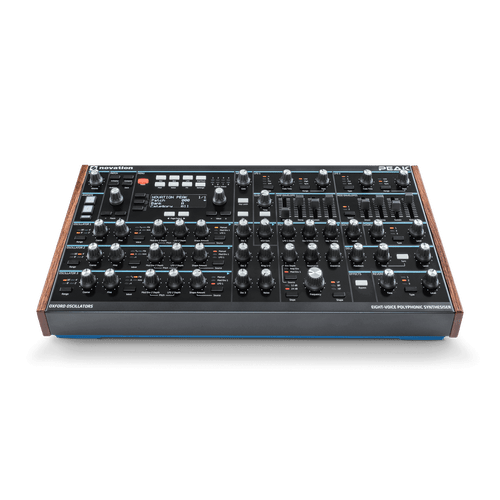Description
Peak is an eight-voice desktop polyphonic synthesiser built around New Oxford Oscillators that combine the best of analogue sound and digital flexibility – including inbuilt and custom digital wavetables. With a resonant multi-mode analogue filter for each voice, and three separate points of distortion per voice, it’s truly the best of both worlds.
Polyphonic aftertouch, an extensive mod matrix, and two dedicated Animate buttons allow for endlessly expressive performances, while lush onboard reverb, delay and chorus round off a formidable addition to any sound designer’s arsenal.
Key Features
- Digital where it counts — Digital FPGA-generated New Oxford Oscillators for analogue-style, wavetable and FM synthesis
- Analogue where it matters — an analogue filter, analogue VCAs and three stages of analogue distortion per voice
- High-quality digital effects — stunning reverb, delay, and chorus effects are instantly accessible via the effects section
- Extensive modulation system — 16-slot modulation matrix and 16 direct assignments controllable from the front panel
- Wavetable Editor — featuring drawing tools and a Live Edit mode, so you can draw your own oscillator shapes and preview them in real time

Analogue where it matters – digital where it counts


Build and refine new sounds from scratch

Connect to just about anything
You can plug Peak into your Mac or PC via USB and start playing. It also has MIDI I/O on five-pin DIN ports, so you can connect your other MIDI gear. Oh, and did we mention it connects to modular systems via a CV modulation input?
Where does Peak fit in your set-up?

Peak Firmware Update v2.0
In Novation’s biggest update for Peak, firmware update v2.0 brings a multitude of features across stereo controls, modulation and unpredictability, and effects, that give you powerful tools to shape your sound.
Create more intricately textured soundscapes with updated stereo controls. Experiment with expansive sound design with modulation and unpredictability. A range of effects improvements bring new tonalities with the addition of Chorus Modes, Flanger, Phlanger, new effects modulation destinations and Lo-Fi delay.
Free patches for Peak
Overview
-
42 Control knobs
8 35mm Sliders
1 Volume knob
2 Data encoders
Rubberised knob caps with spun metal discs
30 Function buttons (not lit)
16 Function buttons (lit)
2 Animate buttons plus hold button
90 Indicator LEDs
OLED display
Kensington Security Slot
Power switch
Power supply connector
USB B 2.0 / MIDI comms only (no bus-power)
MIDI In / Out / Thru
2 1/4" jack socket for continuous or switched pedals
3.5mm jack socket for CV in
1/4" jack sockets for left and right outputs
1/4" jack socket for headphone output
Metal chassis with American walnut wooden end cheeks
Metal magnetic inset end pieces
Dimensions
- Width233mm
- Depth464mm
- Height70.5mm
Software compatibility
-
Ableton Live Lite is included
Peak is a USB-MIDI class compliant device
Power requirements
-
Maximum power consumption 12V DC 1A
Synth engine
-
8 voice polyphonic (voice modes available unison etc.)
Mono-Timbral
5 Voice Modes - Mono, MonoLG, Mono2, Poly, Poly2
Per voice
-
3 oscillators
1 noise generator
1 ring modulator
2 LFOs
1 Amp envelope and 2 mod envelopes
1 Filter
Waveforms include
-
Sine, tri, sawtooth, square / pulse plus 17 wavetables of 5 waveforms per row
Filter
-
1x State variable OTA filter per voice
12/24dB slope
Low-pass / band-pass / high-pass
Pre-filter overdrive
Post-filter distortion
Modulation
-
16 modulation slots per patch
Each slot has 2 sources to 1 destination
Effects
-
Analogue distortion
Chorus - 3 types
Delay with 16 types of delay sync, LP and HP damping, slew and stereo
Reverb - 3 types
Misc
-
Arpeggiator w/ key latch – 33 patterns
Patch storage - up to 512 on hardware (ships with 256 factory patches)
Glide
All knobs (excl. volume), sliders and most buttons transmit and receive MIDI cc commands for external control and mapping














